The following have been identified by the University as key environmental aspects of its daily activities:
Any impact on our students, our staff or stakeholders is mitigated by the University's proactive use of measures and monitoring programmes. |
| |
~top~ |
| |
���ջ{���A�դ���`���ʪ��D�n���O���D�A�i�k�Ǭ��H�U���I�G
���K���ͩM��L�����H�h����ìV�v�T�A���չ�樾�w���M�A����U�ر��I�M�ʴ��p���A��C�ìV�{�סC |
| |
~����~ |
| |
~~~~~~~~~~~~~~ |
| |
|
| |
| If not properly controlled, fugitive emissions, dust in particular, are easily generated during construction and renovation. To prevent dust nuisance and smoke emissions, contractors are instructed to take measures such as proper coverage of construction materials and wetting, spraying and washing to suppress dust. In addition, prefabrication has been adopted to reduce air pollution on site during construction. This reduces the amount of on-site work such as cutting, sawing and nailing of materials, thereby reducing emissions and / or nuisance to the general public.
The Transport Unit regularly and effectively checks the shuttle fleet, all of whose vehicles have been fitted with diesel oxidation catalytic converters. |
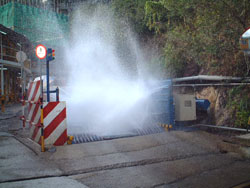
A vehicle wash set up at the entrance of construction sites to eliminate dust.
�ؿv�u�a�J�f�B�]�߬~�ަ��A�~�h�����ǹСC
|
|
| This ongoing preventive maintenance programme keeps all vehicles in top mechanical condition, so that they operate in the most efficient manner and with the least impact on the environment. To reduce exhaust produced by campus vehicles, the Estates Management Office (EMO) also introduced three electric scooters in April 2002; two more have since been added. These scooters do not emit any exhaust and engine noise. |
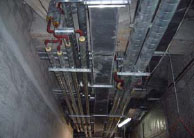 Pre-insulated Pipework �w��O�ŧN����� |
A green scooter's battery must charge five to six hours for two to three hours' use. An electric scooter consumes in excess of $1,000 worth of electricity per year, much cheaper than the $5,000 annual cost of fuel for a traditional scooter. Additionally, an ��Engine Off, Wait for Green�� promotion is raising drivers' awareness of green driving practices. Some buildings, e.g. the Mong Man Wai Building and the Ho Sin Hang Engineering Building, have been designed with elevators that provide access to different levels of campus, while footpaths with enhanced streetscaping have been constructed to promote a pedestrian campus. Such measures reduce air pollution due to traffic. |
|
| Indoor air quality (IAQ) is a growing concern since most people spend more than 70% of their time indoors. Poor indoor environment may lead to discomfort, ill health, absenteeism and low productivity. Therefore, it is necessary to keep the workplace clean and adequately ventilated. The Campus Development Office (CDO) hired a qualified examiner to carry out an indoor air quality survey on campus from 2004-2005. The survey used in-situ measurements, sampling and laboratory analysis to monitor 12 IAQ parameters stated in the EPD's ��Guidance Notes for the Management of IAQ in Offices and Public Places��. It was found that the IAQ of most CUHK offices and buildings could be classified as ��Excellent�� following remedial measures. |
| |
|
| |
| ~ �Ů�ìV���D ~ |
| |
 CUHK's green scooter fleet, unique among Hong Kong's tertiary institutions, is completely exhaust-free. CUHK's green scooter fleet, unique among Hong Kong's tertiary institutions, is completely exhaust-free.
����j�Ǿ֦�����j�M�|�հߤ@�����O�q�ʼ��������C
|
�ؿv�M½�s�u�{�p�L��������A�|���ͦìV���A�S�O�O�ǹСC���F����ǹЩM�·ϡA�ӥ]�ӥ����̷ӫ��ܡA�Ĩ��J�w
���I�A�Ҧp�\�n�ؿv���ơB����B�Q�����x���B�M�~�u�a���C���~�A�ӥ]�ӱĥιw�s�ؿv�ե�C�o�Dzե�i��֤u�a
�W���ΡB���}�B�v�c���u�@�A�P�ɴ�֦ìV���Ʃ�A�H�K�ìV�Ů�A�綠�����Z�]���֡C ��q�թw���ˬd�դ�����ڤh�A�ƨ����ġC�ڤh���ˤW��o�ʤƦ��b�ƾ��C�����w���M�����p���A�ϩҦ�����
�ʯ�O���q�p���A�A�樫�ɹ����Ҽv�T��̤ܳ֡C�G�s�s�G�~�|��A���~�z�B����֮ն騮�����ͪ��o��A�ĥΤF
�T���q�ʼ������A���W�ܤ����C�q�ʼ��������|���ͼo��B�·ϡA�ӥB�D�`���R�A���U��֪Ů�ìV�ξ����C�o��
���O�������C�Ѷ��R�q���B���p�ɡA�Ѩ�B�T�p�ɨϥΡF�C�~�ӹq�q�O�d�h���A��Dzιq�樮�C�~���d���U�ƶO�K�y
�o�h�C���~�A�դ蹪�y�Ҧ��q���u�������͡v�A�[�j�r�������O�N�ѡC�X�����ӡB�Ťu�{�Ǥj�ӵ��ؿv���A����
���a�γ]�p�A�ɭ����i��F�ն鰪�C�� |
|
| �����a���C�դ��h�B���}�P�F�p�|�A�[�H���ơA�ȨD�ն��K�B��A��֨���
�y�����Ů�ìV�C �ѩ�j�����H�C���H�W�ɶ����b�Ǥ��A�Ǥ��Ů����D�`���n�C�c�H���Ǥ����ҡA�����O�H���A�A���l���d�A�ӥB�|
�W�[�ʶԲv�A���C�Ͳ��O�C�]���A�u�@�a�襲���O���M��A�Ů�]�����Q���y�q�C�G�s�s�|�ܤG�s�s���~���A�ն�o
�i�B�u�ЦX����q���A�i�}��a�Ů����q�פu�@�A��˨ѹ���Ǥ��R�A�D�o���O�p�m�줽�ǤΤ����a��Ǥ��Ů��
�T�z���ޡn�ҦC���Q�G�ӰѼơA���G�o�{���տ줽�ǩM�ؿv���Ǥ��Ů����j�����ζ��y�[�վ�A�Y�F��u�u�}�v
���ǡC |
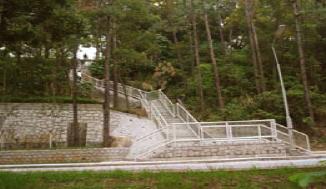
Steplink from Mong Man Wai Building to Clinic Road
�ѻX�����ӦܫO��������H�|
|
|
| |
~����~ |
| |
~~~~~~~~~~~~~~ |
| |
| ~ Energy Consumption ~ |
| |
| CUHK possesses the largest campus area in Hong Kong: 38 blocks of staff residences, 27 blocks of student hostels and over 60 blocks of academic and administrative buildings housing various facilities such as classrooms, libraries, laboratories and other communal amenities. Electricity consumption is quite high as is the trend to increased use due to rapid campus expansion and an increasing number of staff and students. To curb the trend to increased electricity consumption, the Energy Savings Task Force has conducted detailed studies and consolidated a proper course of energy conservation actions in 2004 as follows: |
| |
| Campus-Wide Benchmarks of CUHK |
|
Board Grant (BG) Expenses for he CUHK campus
|
Fiscal Year |
1999/2000 |
2000/2001 |
2001/2002 |
2002/2003 |
2003/2004 |
2004/2005 |
Gross Floor Area (GFA) for Non-residential Areas, (m2)
|
232,432 |
254,370 |
254,370 |
260,360 |
260,360 |
267,975 |
enchmark, kWh/m2
|
281 |
269 |
271 |
264 |
262 |
260 |
Unit Rate, $/kWh
|
0.778 |
0.773 |
0.767 |
0.762 |
0.750 |
0.753 |
|
| |
|
| |
| --- Energy Management and Strategies --- |
| |

Educational Pamphlet for Energy Conscious Temperature Setting
���O�ǷŤp�A�n
|
The Energy Saving Task Force has planned a series of strategies and programmes to coordinate and promote energy conservation through Energy Policy, Energy Guidelines, Energy Saving System & Organization, Energy Index & Benchmarks, Energy Conservation Promotion & Education,
Supports on Energy Conservation Installation, and Energy Survey. In 2005, in order to get in line with HKSAR environmental policy, a circulation letter was issued to all departments and units to
reduce energy consumption through the following recommended energy saving measures: |
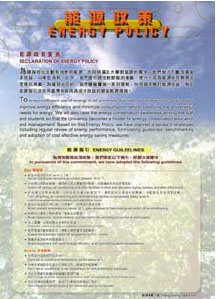
Energy Policy and Guidelines Poster
��F������
|
|
|
|

Consumption Pattern of Mong Man Wai Engineering Building
�X�����u�{�Ǥj�ӯ�ζq���G
|
|
(a) Set indoor air temperature at 25.5oC in summer months; &
(b) In winter months, when the outdoor temperature is below 20oC, maintain appropriate indoor air ventilation, using the fan system without the cooling function. |
| |
~top~ |
| |
| --- Energy Conservation Measures --- |
| |
The University takes a proactive approach to Energy Conservation. Numerous measures initiated by the Energy Saving Task Force were implemented by the Estates Management Office, such as:
- Campus-Wide Lighting Retrofit Programme
- Installation of Energy Efficient Water-cooled Air-conditioning system ��
- Installation of Building Management System ��
- Tariff Switching ��
- Installation of Occupancy Sensors ��
- Power Factor Improvement ��
- Installation of Indirect Evaporative Water-cooling System
��
- Energy-Conscious Building Operation
��
- Decommissioning Works
��
- Adoption of Renewable Energy
|
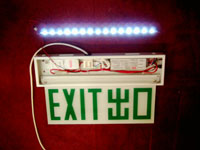
LED Exit Sign
�o���G����X���O�c�˸m |
.jpg)
Occupancy Sensor
�۰ʷP�����˸m |
|
| |
| |
~top~ |
| |
| --- Renewable Energy --- |
| |
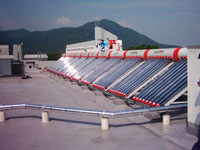
Phase I Solar Hot Water System in Cheung Chuk Shan Amenities Building
�Ĥ@�� 11�M�u�ż��ɺަ��Ӷ�������� (�i�����v�ͱd�֤j��) |
Renewable energy is sustainable, clean and abundant. It can be solar, hydro, or geothermal, or derived from wind, tides, waves or ocean sources, etc. In summer 2004, a pilot solar project was initiated by the Energy Saving Task Force. Eleven sets of evacuated tube solar heating collectors were installed in the Cheung Chuk Shan Amenities Building by the Estates Management Office. Following the success of the Phase I Project, 21 sets of evacuated tube solar heating collectors were installed in the Sports Centre in 2005. Unlike the conventional flat plate type solar heater, this type of solar collector makes use of new technology for better energy efficiency. The transparent evacuated tubes of the solar collectors act like a vacuum flask |
| to minimize heat loss, while permitting absorption of solar radiation. Heat is captured and transferred by the tubes, greatly increasing efficiency. On sunny days, hot water up to 90oC can be provided by the system. Solar-heated water is regulated by a thermostatic valve before utilization. The system is designed to have a capacity of 250 showers per day. Photovoltaic panels have also been installed for lighting and to power the fountain in the Lady Shaw Solar Garden.
Two natural streams flow through the University campus and empty into Tolo Harbor. To fully utilize this natural resource, the Estates Management Office installed a hydraulic ram pump to deliver stream water to storage tanks for irrigation and flushing. The pump converts the kinetic energy of water to potential energy through water power and has a lifetime of more than 30 years. |
.jpg)
Phase I Solar Hot Water System in the University Sports Centre
�ĤG�� 21�M�u�ż��ɺަ��Ӷ�������� (�j����|����) |
| |
|
| |
~top~ |
| |
~~~~~~~~~~~~~~ |
| |
| ~ ����� ~ |
| |
| ����j�Ǿ֦�����̤j���ն�A�b�o���ն�W�]���T�Q�K�y��¾���J�٩M�G�Q�C�y�ǥͱJ�١A���~�٦����Q�h�y�о�
�өM��F�ӤαЫǡB�Ϯ��]�B����ǩM��L���@�]�I�C�ѩ�o�i���t�A���ͤH�Ƥ��_�W�ɡA�ӹq�q�ư��A����W
�[�ͶաC���F�K��q�O���Ӥ��_�W���ͶաA�`����u�@�p�թ�G�s�s�|�~�ԲӬ�s���ժ�����ӱ��p�A��q�F�`
�������ڱ��I�A�Ա��p�U�G |
| |
| ����j�ǥ��կ���� |
|
���j�ն�C�~�O�� |
Fiscal Year �]�F�~�� |
1999/2000 |
2000/2001 |
2001/2002 |
2002/2003 |
2003/2004 |
2004/2005 |
�D���v�Φa���ؿv���n���褽��
|
232,432 |
254,370 |
254,370 |
260,360 |
260,360 |
267,975 |
���СA�d�ˤp�ɡ��C���褽��
|
281 |
269 |
271 |
264 |
262 |
260 |
��즬�O�A�����d�ˤp��
|
0.778 |
0.773 |
0.767 |
0.762 |
0.750 |
0.753 |
|
| |
~����~ |
| |
| --- ��z��� --- |
| |
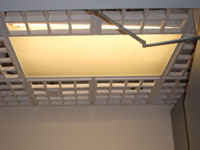
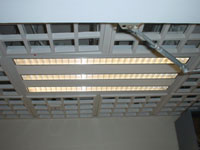
Lighting Retrofit Programme
�ө��t��½�s�u�{
|
�b��z�譱�A�`����u�@�p�ը�w�@�t�C�`�൦���έp���A�h��դα��ʸ`����R��F���B����ޡB��z�β�´�[�c�B����Ӷq�t�Ƥΰ�ǡB�`��ŶǤαШ|�B�`��u�{�F���䴩�θ`��ݨ��լd�C�b2005�~�A���t�X����S�ϬF�������O�F���A���j�w�V�U�����o�X�[�j�`�౹�I�q��A�P�ЦU��������H�U�`�౹�I�R
(a) �b�L�u��Žճ]�w�� 25.5oC �C
(b)�b�V�u���ǥ~��ŧC�� 20oC �ɡA�������Žըt�Τ��s�N�����A�u�Ұʳq���t�ΡA�O���Ů�y�q�C |
|
| |
|
~����~
|
| |
| --- �`�౹�I --- |
| |
���j����l�O�O�@���ҡA�Ѹ`����u�@�p�մ��ת��`�౹�I�A�b���~�z�B��U�U���]�A��:
- �ն�ө��t��½�s�u�{
�� - ���N���Žըt�Φw�ˤu�{
�� - �Ӧt�]�Ʀ۰ʤƨt�Φw�ˤu�{
�� - ��ΦX�A���O�Ҧ�
�� - �w�˦۰ʷP����
�� - �ﵽ�\�v�]��
�� - �ϥζ����]�o���N�o
�� - �Ӧt�`��@�~
�� - ��L�ѳ]��
�� - �ĥΥi�A�ͯ
|

Indirect Evaporative Water-cooling System
�����]�o���N�o�t��
|

Water-Cooled Air-conditioning Plant in
SFARSC
�W���`�|���N���ߤ������N�Ž�
|
|
| |
|
| |
| --- �i�A�ͯ --- |
| |
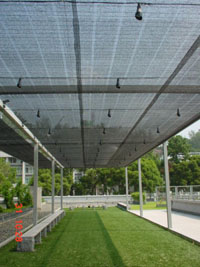
|
�i�A�ͯ�O�Ѧ۵M���͡B�i����b��A���F���ۤӶ��A��i�Ѥ��O�B�a���B���O�B����B�i���M���v�����͡C �Ѹ`��u�@�p�մ��סA���~�z�B�w�v����2004�~�b�i�����v�ͱd�֤j�ӧ����u�Ĥ@���u�ż��ɺަ��Ӷ���������u�{�v�A�ӲĤG���u�{��w��2005�~�����C�ĤG���u�{�W�Ҹ��Ĥ@���j�A�@��21�M�Ӷ���������w�˦b�j����|���ߤѥx�A�u�ż��ɺަ��Ӷ�����������O��H�����O���Ӷ���������A�Ӽ������ϥ������O�ų����u�ť~�h��ּ��O�y���A�Ψϥμ��ɺޫP�i���O�����ζǻ��A�j�j�����t�ήį�A�b��Ӯɥ����ťi�F90oC�A�����g�շū����|���ߤΨW���ӯD�DzO�D���ΡA�Өt�γ]�p�ζq���C��250�h�H�C���~�A�٦b��h�ҤҤH�Ӫ��u�Ӷ�����v�ϥΥ��A�l���Ӷ���H�ѷө��t�ΤμQ�������ΡC |
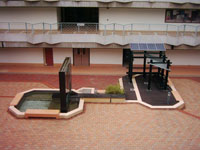
Solar Garden of the Lady Shaw Building
��h�ҤҤH�ӤӶ����� |
���j�o�ѿW�p�A�̤s�Ĥ��A�ն餺������ѵM�s�ˡA�j�q�s�ˤ��y�g�j�Ƕi�J�R�S��C���R���Q�Φ��귽�A���~�z�B�b�˼�w�ˤ��N���[�����W�x�����A�@�O��B�R�Z���ΡC�Ӧ��t�ίS�O���B�A�O���O���ʪ��A�i�N�j���Q���@�y�g�����ˤ��⩹������40�h�̰����x�����A�t�ιةR�i�F�T�ƤQ�~�A��b�L�ìV�C |

Hydraulic Ram Pump
���� |
| |
|
|
| |
|
| |
~~~~~~~~~~~~~~ |
| |
| ~ Noise & Vibration ~ |
| |
.jpg)
Natural landscape used as a noise barrier.
�ն餺�a�դξ��Q�Χ@�ѵM�������̻١C |
Some noise is inevitably produced during construction and renovation. The University has introduced a number of measures over the years to reduce the impact of this noise. Firstly, construction work is not allowed on campus from 7:00pm to 7:00am on weekdays and completely forbidden any time on Sundays or public holidays. Particularly noisy work is restricted to pre-office hours, lunchtime and afternoon office hours to avoid undue disturbance to classes and office operations. All major works are scheduled in the summer months to avoid disturbance. Apart from this, the works department will liaise with offices located in affected areas to co-ordinate schedules. |
| Environmentally friendly methods are always considered at the design stage wherever practicable. Off-site prefabrication, block pavers, low noise surfacing in road construction and quieter equipment are adopted in projects to reduce noise nuisance. Natural landscape and planting are also used as noise barriers. |
|
| |
|
| |
| ~ �����ξ_�� ~ |
| |
| �ؿv�M½�s�u�{�A�h���`�|���;����C���զh�~�Ӥw�Ĩ����ֱ��I�A��־������v�T�C�����A�ն饭��ߤW�C�ɦܤW�ȤC�ɸT��I�u�A�P���ѩM�������������T��C�S�O�˧n���u�{�A�ʤu�ɶ�����줽�ɶ����e�B�ȿ��ɶ��H�ΤU�ȿ줽�ɶ��A�ɶq��ֹ�оǩM�줽�Ǥu�@�����Z�C�Ҧ��j���u�{�A���w�Ʀb�����I�u�C���~�A�t�d�u�{�������|�M���v�T���줽���p���A���ۤF�ѡA�H�K�����w�ƬI�u�ɶ��C ���պɥi��b�u�{�]�p���q��w���O���I�A�Ҧp�w�s�ؿv�ե�B�Q���j�B�����Q�W�R�����ơB�ĥι��R�������A�H��C�����C�����٧Q�ΤѵM���ҩM�Ӿ�k�@�����̻١A��־����ǰe�C |
| |
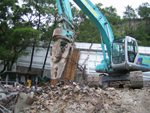
A quieter hydraulic crusher was used in the demolition of the Li Dak Sum Building.
�b���F�T�ϭ��ؤu�{���A�Q�θ��w�R���o�������H���i�����C |
.jpg)
Soundproof windows were installed in the offices of the Fung King Hey Building next to the Li Dak Sum redevelopment site.
�����H�Ӥ����줽�Ǥw�w�˹j���������A��֧��F�T�ӭ��ؤu�{�������v�T�C |
|
| |
|
| |
~~~~~~~~~~~~~~ |
| |
| ~ Waste Management ~ |
| |
| As a tertiary institution with about 5,000 staff and 17,000 students, some of whom live on campus, CUHK generates a huge volume of waste daily in its offices, laboratories, canteens, residences and student hostels. This presents a very difficult environmental problem. The University has made a concentrated effort to reduce hazardous waste through implementing a 4 ��R�� Strategy of Reduce, Replace, Reuse and Recycle in daily activities in the University. |
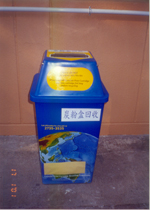 
Recycling Bins for Paper, Aluminum Cans & Plastic Materials
�o�ȡB�T���ζ콦���Ʀ^���c |
|
| |
|
| |
| --- Domestic Waste --- |

Desk-side Recycling Bin
��Ǧ^���c
|
For waste reduction and management of domestic waste, the University has implemented the following measures:
- Providing over 65 strategic recycling points on campus to facilitate recycling with thrice-weekly collections for papers, plastic materials, metals and toner cartridges.
�� - To increase the rate of office paper recycling by 30%, a Desk-side Recycling Programme has been put into effect, with over 2,000 bins provided.
�� - Implementation of regular recycling programmes for clean plastic bags, rechargeable batteries, CDs, old clothes, books, toys, a charity recycling plan, etc.
|
|
| |
| Quantity of Recyclables Recovered |
2001 |
2002 |
2003 |
2004 |
2005 |
2006 |
| Waste Paper (kg) |
240,600 |
238,250 |
254,500 |
257,027 |
340,169 |
326,938 |
| Plastic Bottles (kg) |
865 |
1,090 |
1,290 |
960 |
760 |
700 |
| Aluminum Cans (kg) |
595 |
670 |
849 |
901 |
887.3 |
771.5 |
| Printer Cartridges (No.) |
No Data |
357 |
427 |
277 |
377 |
441 |
|
| |
|
| |
| --- Hazardous Waste --- |
| |
| CUHK recognizes the dangers of hazardous waste and its possible impact on the health and safety of staff and students, as well as on the environment. The University Safety & Environment Office (USEO) manages the disposal of biological and chemical waste generated by the daily operation of the University plant and academic undertakings on campus. Waste disposal guidelines are prepared for the research staff of laboratories regarding proper dumping of the waste generated by laboratory activities. All waste is properly stored until collected and removed by licensed collectors. Moreover, radioactive waste storage is managed by the Radiation Officer of the USEO. |

Biological waste is properly labeled and stored.
�Ҧ��ͪ��o�������M�������ҨþA�����J�s�C |
|
| |
| Year |
Chemical Waste (kg) |
Biological Waste (tons) |
| 1998 |
19,244.0 |
No Data |
| 1999 |
15,852.5 |
No Data |
| 2000 |
24,241.1 |
17.0 |
| 2001 |
28,188.0 |
26.0 |
| 2002 |
34,661.0 |
14.0 |
| 2003 |
36,590.0 |
15.0 |
| 2004 |
37, 676.0 |
15.0 |
| 2005 |
38, 490.0 |
15.0 |
|
| |
|
| |
| --- Construction & Demolition Waste --- |
| |
.jpg)
C&D Waste Sorting Area
�ؿv�o�������s��� |
During the design, construction and demolition phases of building projects, CUHK endeavours to reduce and reuse construction and demolition (C&D) waste materials. To facilitate more waste separation, the University requires contractors to submit a waste management plan outlining their proposed on-site sorting and waste minimisation. Their performance is strictly monitored to ensure the plan is properly carried out.
|
| Additionally, to ensure proper disposal of C&D waste, ��trip tickets�� are closely checked by the site supervisory staff. |
.jpg)
Metal hoarding replaces wooden hoarding.
���ݳ�O���N�F���O�C |
| |
|
| To conserve the timber forest and reduce C&D waste, metal has replaced hardwood for site hoardings, formworks and scaffoldings. Metal-made items are reusable; hence the generation of used timber works as C&D waste is greatly reduced. Apart from that, effective waste management has been adopted in building projects. For instance, in the Li Dak Sum Redevelopment Project, all existing |
|
| furniture was relocated to other offices; all A/C window units were removed for reuse in other buildings; and lighting fittings, timer doors, steel windows, glasses, pipes, cables, etc. were removed and collected by recovery/recycling companies. During the demolition, waste materials were sorted on site and separated into different categories such as quarry products, metal, timber products, surplus excavated materials and general refuse. These surplus excavated materials were used for backfill; the reusable/recyclable materials were reused or collected by recyclers; general refuse was disposed of in landfills; while the non-reusable/non-recyclable demolition materials were sent to public fills following the trip ticket system. |
| |
| Description |
Quantity |
C&D Waste Disposed to Public fill (m3) |
11,125 |
C&D Waste Disposal to Land fill (m3) |
1,111 |
| Recycled C&D Waste (m3) |
8 |
| Metal Recycled (kg) |
185,506 |
Paper Recycled (kg) |
665 |
| Chemicals Recycled (kg) |
350 |
|
| |
|
| |
| ~ �o���z ~ |
| |
| ���զ@�����d�W��¾���B�@�U�C�d�W�ǥ͡A�����H�J�ն�C�줽�ǡB����ǡB����B��¾���J�٩M�ǥͱJ�٨C�ѳ����ͤj�q�o���A�������O�u�@���@�j���D�C��Ų�A���դ@����`���ʳ��^��|R�F���A�P�O��֦��`�o���C�|R�Y���(reduce)�B���N(replace)�B�A��(reuse)�H�δ`���A�y(recycle)�C |
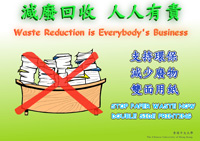 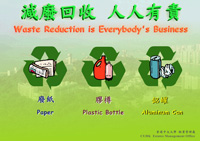
Waste Reduction Educational Posters
��o�p���� |
|
|
| |
|
| |
| ---�a�~�o�� --- |
| |
.jpg)
EMO staff sorts waste in the refuse station.
���~�z�B�|�b�U�����N�o�������C |
�j�Ǧb�a�~�o���z�譱�@�X�H�U���I�R
�� - ���j����65�B�����ʦa�I�A�C�P�������T���o�ȡB���ݡB�콦���Ƥμv�L���ү����C
- �z�L2�d�h�Ӯ�Ǧ^���c�A�줽�Ǽo�Ȧ^���v�W�[�T���C
- ����h�ئ^���p���A�Ҧp�R���b���U�^���B�R�q���B���СB�¦�B�ѥ��B����B�O���^���p���C
|
|
| |
| �i�A�μo�����^���ƶq |
2001 |
2002 |
2003 |
2004 |
2005 |
2006 |
| �o�� (����) |
240,600 |
238,250 |
254,500 |
257,027 |
340,169 |
326,938 |
| �콦�� (����) |
865 |
1,090 |
1,290 |
960 |
760 |
700 |
| �T�� (����) |
595 |
670 |
849 |
901 |
887.3 |
771.5 |
| �C�L�������� (�ƥ�) |
�����έp |
357 |
427 |
277 |
377 |
441 |
|
| |
|
| |
| --- ���`�o�� --- |
| |
| ���ղ`���M�I�o�ƩM���Ͱ��d�B�w�����������A�����Ҥ]���Y���v�T�A�S�O�e���j�Ǧw�������ҨưȳB(���ҨưȳB)�A�t�d�B�z�ն��`�B�@�H�αоǮɲ��ͪ��ͪ��M�ƾǼo�ơC�j�Ǩ�q�F�o�Ʊ�m���ޡA���ܹ���Ǭ�s�H��������m���粣�ͪ��o�ơC�M�I�o�Ƥ@�߶������x�s�A�ݫ��P�����Ӧ����B���C��g�ʼo�ƫh�x�s��I�ܭܤ��A�����ҨưȳB����g���@�D���t�d�z�C |
.jpg)
Licensed collectors are employed to collect chemical and biological waste for disposal.
�ƾǤΥͪ��o���ѫ��P�������Ӧ����B�B�z�C |
|
| |
| �~�� |
�ƾǼo�� (����) |
�ͪ��o�� (��) |
| 1998 |
19,244.0 |
No Data |
| 1999 |
15,852.5 |
No Data |
| 2000 |
24,241.1 |
17.0 |
| 2001 |
28,188.0 |
26.0 |
| 2002 |
34,661.0 |
14.0 |
| 2003 |
36,590.0 |
15.0 |
| 2004 |
37, 676.0 |
15.0 |
| 2005 |
38, 490.0 |
15.0 |
|
| |
|
| |
| --- �سy�Ω���u�{�Ҳ��o�� --- |
| |
.jpg)
.jpg)
Using surplus concrete to form multipurpose concrete blocks.
�Q�γѾl�V���g�Ͳ��h�ؿj���C |
���պɥi��b�سy�Ω���u�{�����A��֤ΦA�ΩҲ��ͪ��o���C���F��K�o�������A�n�D�ӿ�Ӵ���o���B�z�p���ѡA������˦b�u�a�W��o�������A�ô��̤֡C�t�d�����Y��ʹ�ӿ�Ӫ��{�A���P�L�̷̨өҩw�p�B�z�o���C���~�A�u�a�ʷ�¾���|�p���ˬd���B�O���A�ȨD�سy�Ω���u�{�Ҳ��o���B�z�o�y�C ���ݾ����i�H�h���ϥΡA�]�����ձĥΪ��ݥN�����@�a�L��O�B�ҪO�B�[���A�H�O�s�L��δ�֫ؿv�M����u�{�Ҳ��o���C���~�A�Ҧ��u�{����I���Ī��o���B�z�k�C�Ҧp�b���F�T�ӭ��حp�����A�Ҧ��è㳣�h���L�줽�ǨϥΡF�Ҧ����f���Žթ�U����A���h�h�Ѩ�L�ؿv���ϥΡF�ӷө��]�ơB�w�ɪ��B�����B�����B���ޡB�q�l���A���Ѵ`���A�y���q����h�C��ɡA�o�����������O���A�Ҧp���q���~�B���ݡB������~�B�W�B���X�����ơB�@��U�����C�W�B���X�����Ƨ@�^��ΡF�i�A�Ϊ��ƥѴ`���A�y���q�A�ΩΦ��h�F�@��U���|�����ϡF�Ӥ��i�`���A�Ϊ�����Ҳ����ơA�h�̷Ӹ��B�O����סA������ϡC |
|
| |
| ���e |
�ƶq |
| ������� �]�ߤ�̡^ |
11,125 |
| �����ϡ]�ߤ�̡^ |
1,111 |
| �سy�Ω���u�{�o���`���A�Ρ]�ߤ�̡^ |
8 |
| ���ݴ`���A�Ρ]����^ |
185,506 |
| �o�ȴ`���A�Ρ]����^ |
665 |
| �ƾǫ~�`���A�Ρ]����^ |
350 |
|
| |
|
| |
~~~~~~~~~~~~~~ |
| |
| ~ Water Usage & Discharge ~ |
| |

Stream Course beside Alumni Trail
�դͮ|���p���y�� |
In 2005, the University consumed 1,284,000m3 of water . To minimise water consumption, we continued our effort to reduce water wastage in our administrative and academic buildings through, for example, installation of automatic cut-off taps in restrooms and posting notices and stickers as reminders to use less water. Seminars, workshops and competitions were also launched to encourage staff and students to save water. Apart from this, the University also removed the sludge from Wei Yuan Lake and installed an automatic water-gate; |
deepening the lake to increase its capacity by ~2,600m3 so that 700 m3 of lake water can be used per day for flushing, irrigation and air-conditioning systems.
|
.jpg)
Automatic Water-gate at Wei Yuan Lake
����۰ʱƬx�t�� |
| A network of storm drains and sewers has been developed on campus over the past three decades to protect the surrounding water bodies and ensure proper discharge. Storm drains were built to collect rain |
|
| water and surface run-off from road surfaces and rooftops, and to divert this into the natural watercourses. Contaminated wastewater generated by residences, student hostels, offices,
laboratories, canteens, etc, is discharged to the sewers and conveyed to the Shatin Treatment Works for disposal. Due to the installation of grease traps in the canteens and restaurants by the COD, grease and oil content are well within the limits stipulated by EPD.
For construction sites with effluents, contractors must apply for a discharge license from the Environmental Protection Department (EPD) and comply with license requirements, such as installation of wastewater treatment facilities connected to the approved discharge point. A wastewater sedimentation system must be set up at the construction site to facilitate water reuse. |
| |
|
| |
| �Τ��αƤ� |
| |
| �G�s�s���~�A���զ@�Τ��@�ʤG�Q�K�U�|�d���褽�ءC���F��֯Ӥ��q�A�U��F�ξdzN�Ӧt�~�����`���Τ����I�A�Ҧp�b�~�ⶡ�w�˷|�۰����W�����s�Y�A�ñi�K�i�ܩM�K�ȡA�����p�Z�̤��Ů��O�����C�������|���Q�|�B�u�@�{�B���ɵ��A���y���`���Τ��C�P�ɡA���եh���F�����êd�A�w�˦۰ʤ��h�A�åB�[�`�A�Ϯe�q�W�[�G�d���ʥ��褽�ءA�{�b�C�Ѧ��C�ʥ��褽�ش���ѨR�Z�B��@�B�N�o�Žըt�ε��γ~�C �L�h�T�Q�~�A���ճ���إߤF�@�ӫB����M�ä���զ����Ƥ��t�ΡA�H�O�@�P����A�ýT�O�Ƥ��Z���C�B�����B���M�����B�γ����y���ޤJ�ѵM���D�F�ä���h���¾�����v�B�ǥͱJ�١B�줽�ǡB����ǡB���Ҳ��ä��ީ��F�Цä��B�z�t�C���~�A�ѩ�U����B�\�U�w�ˤF�j�o���A�ä����o�צ��������ŦX���O�p�W�w�C |
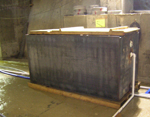
Wastewater sedimentation tank established at construction site to facilitate water reuse.
�ؿv�u�a���]���I�����A�����o���A�ΡC |
| �ؿv�u�a�p���Ʃ�ä��A�ӥ]�ӥ����V���O�p�ӽбƦõP�ӡA�ÿ��u�o�P�W�w�A�Ҧp�w�˦ä��B�z�]�I�A�����g��㪺�Ʀ��I�C���~�A�ؿv�u�a���w�˦ä��I���t�ΡA���]���i�H�A�ΡC |
|
| |
|
| |
~~~~~~~~~~~~~~ |
| |
| |
| |








